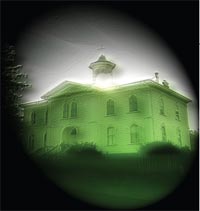
Haunting and Gathering
Things that go bump in the night are sometimes the least of these professionals’ concerns.
 Sure, there are the apparitions, noises, disembodied voices, and objects moving of their own accord, sometimes flying across the room. And, yes, temperatures can suddenly drop, and strange, often nauseating smells can fill a room for no apparent reason. Occasionally, though rarely, personal attacks by unseen assailants can be involved. Such phenomena simply go with the territory for the paranormal investigators commonly known as ghost hunters. But in their quest to gather empirical evidence of the afterlife and otherwise explain the unexplained, these investigators also routinely encounter a witches’ brew of conventional job hazards, any one of which should give self-respecting safety directors the creeps.
Sure, there are the apparitions, noises, disembodied voices, and objects moving of their own accord, sometimes flying across the room. And, yes, temperatures can suddenly drop, and strange, often nauseating smells can fill a room for no apparent reason. Occasionally, though rarely, personal attacks by unseen assailants can be involved. Such phenomena simply go with the territory for the paranormal investigators commonly known as ghost hunters. But in their quest to gather empirical evidence of the afterlife and otherwise explain the unexplained, these investigators also routinely encounter a witches’ brew of conventional job hazards, any one of which should give self-respecting safety directors the creeps.
Slips, trips, and falls from height, for example -- the horrors of many a normal workplace -- are standard risks on practically every ghost-hunting expedition. Depending on the condition of the home, building, or grounds being investigated, these hazards can be exacerbated by the amount of electronic equipment involved, much of it corded, and the fact that most of the actual investigating is done in unfamiliar places -- and in the dark.
“Flashlights are crucial to a ghost hunter’s toolkit, as are loads of extra batteries,” notes Donna Kent, founder of the Cosmic Society of Paranormal Investigation (www.cosmicsociety .com) and author of Ghost Stories and Legends of Eastern Connecticut. “Batteries have a way of going dead during investigations. Spirit energies will just usurp that, using the energy to manifest.”
Like most professionals in the field, Kent has a day job to support her nocturnal pursuits. Her experience as an inspector of commercial and residential buildings gives her unique insight into ways to minimize risk once the sun goes down. “The first thing is for ghost hunters to do their field work -- researching the chosen site, surveying the location by foot in daylight, looking for potentially hazardous areas, raised or uneven surfaces,” she says. “In graveyards, beware of small footstones or small, worn-down tombstones, which may pose a tripping hazard. Of course, open graves are never fun to drop into. Also, you have to remember to watch for low beams or ceilings, especially in older and historic homes. People were shorter hundreds of years ago.”
Sherry Lemay, who works in a hospital sleep clinic when she’s not on a case with Paranormal Investigators of New England (www.pinewengland.com), notes that, contrary to popular perception, most ghost hunting does not take place in condemned or abandoned buildings, which can be riddled with rotten wood, unrailed staircases, asbestos, and other harmful agents. She adds, however, that even in otherwise perfectly inhabitable structures -- homes or workplaces “condemned” only by paranormal presences -- the hazard potential can be high. “Indoors, we do a lot of crawling in crawl spaces and climbing up to attics or down to basements, and we deal with electrical issues all the time, doing sweeps, checking for leakage current. ”The theory behind the leakage checks and investigators’ ubiquitous use of electromagnetic field detectors, she says, is that high EMF readings can contribute to people having hallucinations or to making them feel they’re being watched.
Who Ya Gonna Call?
Because one of ghost hunters’ primary goals is not becoming ghosts themselves, PINE, like many teams, enforces a buddy system for both safety and verification purposes. “Indoors or out, we always use walkie-talkies and cell phones, and we never ever go anywhere by ourselves,” Lemay says. That way, if one investigator is focused on the equipment, another will always have his or her back.
Investigator Joshua P.Warren, founder and president of LEMUR (League of Energy Materialization and Unexplained phenomena Research) Paranormal Investigations (www.lemurteam.com) and author of several books, including How to Hunt Ghosts: A Practical Guide, admits he has on occasion broken the cardinal “buddy system” rule. In fact, one of his solo expeditions, a one-man documentary called “Alone in a Haunted House,” had best-selling results.
“Generally it’s the little things you have to look out for,” he says. “In attics, basements, or outside, it’s the black widows, the broken glass, the snakes. On the other hand, you might be in that environment one day, and the next day you’re in a five-star hotel looking for the Pink Lady that floats down the hallway. So you just never know which end of the spectrum the investigation will take you on.”
Having conducted more than 500 haunted house investigations, Warren says he typically relies on a multi-pocketed, water-resistant utility vest to hold all necessary tools of the trade, keeping his hands as free as possible. The vest and a sturdy pair of boots are essential components of personal protective equipment, he says. Kent notes, however, that, given the nature of the work, PPE alone may not always offer sufficient protection.
“There are many other things on a spiritual level that ghost hunters need to do that we may never consider, because you’re dealing with supposedly something from another dimension, ”Kent says. “Your belief system -- and the amount of faith you have in it -- is a big part of it.”
This article originally appeared in the October 2008 issue of Occupational Health & Safety.